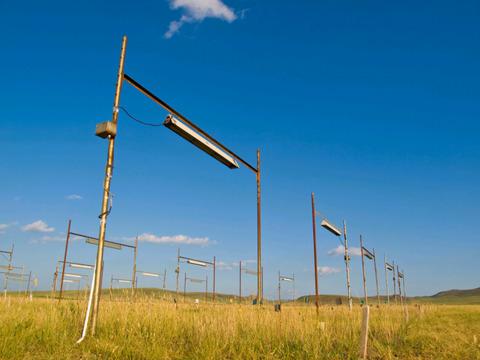当前位置:
X-MOL 学术
›
Funct. Ecol.
›
论文详情
Our official English website, www.x-mol.net, welcomes your feedback! (Note: you will need to create a separate account there.)
Nighttime warming enhances ecosystem carbon‐use efficiency in a temperate steppe
Functional Ecology ( IF 5.2 ) Pub Date : 2020-05-14 , DOI: 10.1111/1365-2435.13579 Jing Wang 1 , Qian Zhang 2 , Jian Song 1 , Jingyi Ru 2 , Zhenxing Zhou 2 , Jianyang Xia 3 , Jeffrey S. Dukes 4, 5 , Shiqiang Wan 1
中文翻译:

夜间变暖可提高温带草原的生态系统碳利用效率
更新日期:2020-05-14
Functional Ecology ( IF 5.2 ) Pub Date : 2020-05-14 , DOI: 10.1111/1365-2435.13579 Jing Wang 1 , Qian Zhang 2 , Jian Song 1 , Jingyi Ru 2 , Zhenxing Zhou 2 , Jianyang Xia 3 , Jeffrey S. Dukes 4, 5 , Shiqiang Wan 1
Affiliation

|
- Reductions in the diurnal temperature range (DTR), for example, greater increases in daily minimum than maximum temperatures, have occurred for several decades and are projected to continue over this century, which could affect terrestrial carbon (C) cycling. Carbon‐use efficiency of plants (CUEp) and ecosystems (CUEe) represents the capacity of plants to capture C and ecosystems to store C fixed from the atmosphere, respectively. Few studies have examined how grassland CUE responds to asymmetric warming.
- As part of a long‐term (2006–2016) field experiment that simulated daytime and nighttime warming in a semi‐arid temperate steppe on the Mongolian Plateau, this study was conducted to examine the effects of daytime and nighttime warming on CUEp and CUEe.
- Nighttime warming, unlike daytime warming, increased CUEe by 54.2%, whereas neither nighttime nor daytime warming affected CUEp. Ecosystem‐level CUE linearly increased with soil moisture but declined with soil temperature variation (CVST). The suppressed ER, which might have been driven by the reduced CVST, primarily contributed to the higher CUEe under nighttime warming.
- These observations indicate that a reduced DTR, associated with a warmer night under asymmetric diurnal climate warming, could increase the capacity of the temperate steppe transferring C into ecosystems by elevating CUEe, resulting more C sequestration.
中文翻译:

夜间变暖可提高温带草原的生态系统碳利用效率
- 昼夜温度范围(DTR)的降低,例如,每日最低温度的增加大于最高温度的减少,已经发生了几十年,并且预计在本世纪将持续下去,这可能会影响陆地碳(C)循环。植物的碳利用效率(CUEp)和生态系统(CUEe)分别代表植物捕获碳的能力和生态系统存储从大气中固定的碳的能力。很少有研究检查草原CUE如何响应非对称变暖。
- 作为长期(2006-2016年)野外试验的一部分,该试验模拟了蒙古高原半干旱温带草原的白天和夜间变暖,该研究旨在检验白天和夜间变暖对CUEp和CUEe的影响。
- 与白天变暖不同,夜间变暖的CUEe增加了54.2%,而夜间变暖和白天变暖都不会影响CUEp。生态系统水平的CUE随土壤湿度线性增加,但随土壤温度变化(CV ST)下降。受抑制的ER(可能由降低的CV ST推动)主要是在夜间变暖下导致较高的CUEe。
- 这些观察结果表明,DTR的减少与不对称的昼间气候变暖导致的夜晚温暖有关,可以通过提高CUEe来增加温带草原将C转移到生态系统的能力,从而导致更多的C固存。


























 京公网安备 11010802027423号
京公网安备 11010802027423号